
| home | Jean Nicolini | Tutoriais | Observações | Observadores | ROSEP | Retornar | Imagens Rea | Sites Solares | Bibliografia |
ON JULY 11th the Moon's shadow will sweep down from the cold of space and touch Earth. The resulting total solar eclipse will be special because the Moon's shadow will take nearly 7 minutes to pass over some places.
Most amateurs who visit Hawaii, Mexico, or Brazil will watch the spectacle or take photographs. But I hope some will participate in an experiment. It concerns shadow bands, an eclipse-related phenomenon that has been described often but is still inadequately studied.
These mysterious gray ripples are sometimes seen flitting over the ground within a minute or two of totality. The bands are initially faint and jumbled; but as totality approaches, they become more organized, their spacing decreases to a few centimeters, and their visibility improves. After totality ends the bands can reappear and become progressively fainter and more disorganized until they disappear.
Shadow bands seem to move perpendicularly to their length, but this is only an illusion. It stems from a lack of features that allow the eye to track motion along the length of the bands. Their spacing is somewhat smaller when viewed in blue light than in red. Among the stranger sightings reported are bands of different colors, superimposed on ones having different speeds, and giant bands.
While an understanding of shadow bands won't unlock any great secrets of the universe, these eclipse ghosts are a real effect of nature. Although some have suggested that the bands might teach us something about solar physics, they are unrelated to that topic. The overwhelming consensus is that shadow bands are simply an effect of light propagation through Earth's atmosphere. At most they are an amusing diversion before and after the real show.
Since shadow bands are not critical to our understanding of much of anything, the march of science has largely passed them by. But that doesn't make them trivial or suggest that we really understand them; it only means that professionals have chosen to study more promising things. So, from the perspective of an amateur interested in research, there couldn't be a more perfect opportunity than to study these orphans of science.
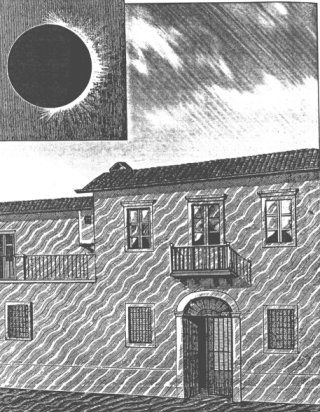
HOW I GOT TO KNOW SHADOW BANDS
My involvement began one February day in 1984, when I read about shadow bands in a Sky & Telescope article by Laurence Marschall. I was working on my doctoral dissertation concerning the mathematical theory of wave propagation through turbulence -- like light passing through air -- so the article was particularly interesting to me. Yet I was amazed that the cause of shadow bands was controversial, since it seemed obvious that it had to be a scintillation effect, just like that which causes stars to twinkle.
The next day Stanley Flatté, one of my mentors, agreed that I was probably right. but he also said that perhaps there was more to the story. In fact, because there is truth to the saying, "To a man with a hammer, the whole world looks like a nail," he challenged me to undertake the investigation.
I spent some evenings working out details, thinking this would be a quick job. How wrong I was! The problem consumed six months of my "spare" time. Although I was eventually able to explain every observed property of shadow bands as a twinkling effect, the puzzle was very complicated. Many pieces played against each other, and the phenomenon turns out to involve optics, meteorology, visual physiology, signal processing, and other disciplines.
Although I ended up with an explanation of shadow bands, what I really did was write a paper in theoretical amateur astronomy! It was published in Astronomy and Astrophysics, August (II), 1986. Nevertheless, this subject still belongs to amateurs, who now have an opportunity to develop better observations to test my theory.
With this article I hope to get every amateur who sees the July 11th eclipse to send a postcard to Sky & Telescope, saying whether or not he or she saw the bands. A lot of information can be derived from even that minimal level of participation. But there are many other observations that can be made by amateurs of every skill and interest. The bottom line is: this is your effect -- help study it!
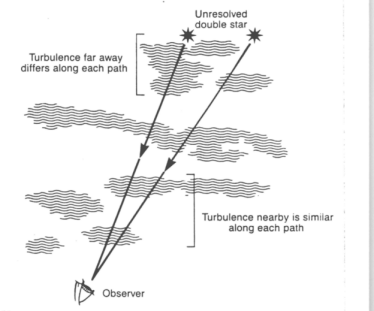
HOW THE BANDS WORK
Light from stars, which are essentially point sources, arrives at Earth in a compact bundle of rays. But light from the Sun, Moon, and planets, which are extended sources, arrives in a much broader cone. The key to understanding shadow bands lies in knowing why stars twinkle but planets don't. Their different behavior is explained by an effect known as "source averaging", which is a product of turbulence.
Turbulence is random swirls and eddies in the atmosphere. This incredibly tangled behavior generates fluctuations in the temperature and density of the air, which alter its index of refraction. Thus, each gust of wind causes incoming light to bend slightly. To visualize the effect, imagine each little turbulent patch as a lens blowing along with the wind.
Consider a twinkling double star that cannot be resolved by the naked eye Since the stars are seen in slightly different directions, the light from each travels to our eye along a slightly differem path. As the diagram shows, when turbulence is near the observer the light from both stars will likely pass through the same turbulent patch and make the two stars twinkle synchronously. But when the turbulence is far away, each light ray tends to pass through different patches, and the two stars will twinkle independently.
Since our hypothetical double star cannot be resolved visually, its twinkling will be the sum of contributions from the two stars. In this situation, twinkling that affects each star independently (from distant turbulence) will tend to average out. Thus, even though turbulence may occur at all distances from the observer, in the end only twinkling caused by nearby turbulence will be visible.
The planets, and even the Sun, can be thought of as being made up of many points of light. If two of these points are close enough together, they will twinkle synchronously; otherwise, the fluctuations will average out. And if the turbulence is far away, the twinkling will be greatly reduced.
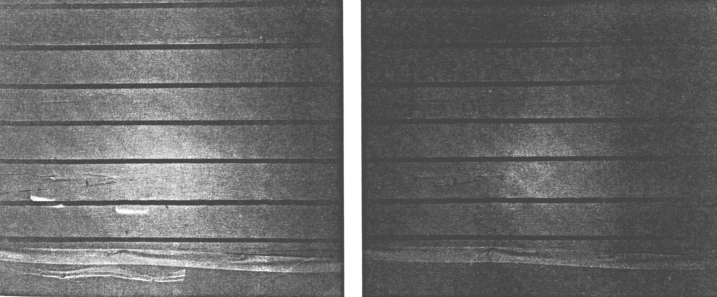
Thus, while the turbulence that makes stars twinkle extends to great altitudes, planets and the solar crescent are affected only by turbulence much nearer the ground. On a hot day you can see an extreme example of this source-averaged scintillation as "heat-wave" shadows in sunlight. They result from the full solar disk "twinkling," though the Sun is far too bright for anyone to see this effect directly. The turbulence responsible for heat-wave shadows probably lies from a few feet to tens of feet above the ground.
Because the solar crescent's size changes rapidly near totality, it adds an interesting twist to the source-averaging effect. A few minutes from totality only turbulence from tens to hundreds of feet from the ground matters in the formation of shadow bands. At 30 seconds the important turbulence extends up thousands of feet. (The distribution of turbulent patches in the atmosphere doesn't change, it is simply that the shrinking solar crescent permits the higher ones to have an effect.) Also, because the crescent shrinks more slowly in length than in width, source averaging is more pronounced along a line joining the crescent's tips. The result is a mottled, smeared-out light pattern that we call shadow bands!
These ideas, combined with a little knowledge about light interference, make it possible to understand typical features of shadow bands. For example, since blue light is more likely to interfere destructively than red light, the net effect is that shadow bands should have more contrast in blue light than in red, as has been observed (see the diagram at top right). Another effect is that the bands should be slightly narrower in blue light than in red.
Many of the shadow bands' characteristics are controlled, strangely enough, by the duration of the eclipse. If the Moon and Sun are very nearly the same size (as in a short eclipse), the last partial phases before totality are dominated by a long- horned crescent, which does not make a very good slit or produce good displays of shadow bands.
Annular eclipses, with the Moon appearing smaller than the Sun, form the ultimate in poor slits. Since the shadow patterns try to line themselves up with the crescent, which in this case is circular, these eclipses will produce only random, smoky patterns with little or no structure.
The best situation for shadow-band production is a long-duration eclipse like the one coming on July 11th. In this case the Moon covers more of the Sun's limb and yields a shorter, straighter slit just before and after totality.
The orientation of the bands depends on where you are in relation to the centerline. If you are standing on it, the Moon will touch one side of the Sun, eat its way directly toward the center of the solar disk, and leave on the opposite side. The solar crescent changes shape but not orientation (see the diagram at left), and the shadow bands will remain oriented perpendicular to the shadow's path.
But if you are off the centerline, the center of the Moon's disk will not pass over the center of the Sun's disk. Thus the crescent will swing around. To take an extreme example, if you stand on the edge of the path of totality, the solar crescent starts out oriented nearly perpendicular to the path. But as the moment of totality approaches, the crescent swings around to be nearly parallel with the path. Shadow bands will follow this rotation, to remain aligned with the tips of the crescent.

SOME EXPERIMENTS TO TRY
Shadow bands offer challenges for amateurs of all skills and abilities. Any contribution is valuable if it is carried out with care and attention to detail. The following suggestions include a variety of observations and experiments that range from very simple to ones that require special equipment and planning.
Visual observations.
The easiest observation is merely to note whether or not shadow bands are present. Also, where are you? What are the weather conditions? Is there any wind? Are trees, buildings, or bodies of water nearby? Note everything and report it. Observations such as these are valuable only if many people report their findings. So take part!
My theory predicts that shadow bands occur in a variety of sizes, including intriguingly large ones. Studies in visual perception show that the eye's ability to see light variations depends on the contrast, size, and ground speed of the pattern. Unfortunately, the contrast of shadow bands doesn't ever exceed 2 or 3 percent with respect to their background. Thus their detectability is restricted to the limited capabilities of our eyes.
At such a low contrast we might easily see light variations at the usual spacing of shadow bands, but we will have a hard time discerning structures larger than about a meter. Yet they probably form at this scale and larger. But shadowy structures of this size would not be visible to someone standing on the ground; they would have to be observed from a distance larger than a person's height.
Thus it might be effective to look down at a fairly featureless surface from as much as 100 feet above it. In Hawaii and Brazil the low solar crescent will provide shallow illumination, so one might look for the large shadow patterns on a distant light-colored blank wall. Anyone attempting this experiment should note the viewing geometry, particularly the wall's geometry with respect to the Sun and you. Whether these large shadows will look bandlike or have a blotchy appearance remains to be seen.
A further limitation of our vision causes all structure to blur together if the pattern moves too fast. This can easily happen if the wind driving the turbulence (and the bands) is much stronger than a light breeze. The bands are still present, but our eyes cannot track them.
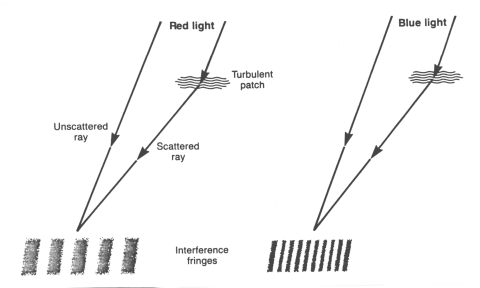
The changing orientation of shadow bands can be judged by laying a sheet or screen on the ground, together with a compass or other directional marker. A typical setup is shown in the photograph on page 486. If you perform an experiment of this sort, try to maintain organization. For example, it's easy to become too excited to note the time accurately, so I suggest using a tape recorder. Of course, you have to tell the recorder precisely what's happening, such as, "Totality starting now!" (Just saying "Wow!" won't help you reconstruct events later.) One useful trick is to use a stereo recorder and tape time signals on one channel and your comments on the other.
If you measure the orientation of shadow bands, you must carefully note your position relative to the centerline of totality. Estimating the orientation when the bands first appear may be difficult, since the bands are likely to be formed by low-altitude turbulence and may look like the shadows of smoke. But after a few moments, as the solar crescent becomes smaller, they should become crisper and their orientation clearer.
An interesting mutation occurs when the bands are formed by turbulence pushed along by winds having different directions and speeds at various altitudes. The result is a superposition of shadow patterns with each having its own speed. The only practical way to validate the observed direction of band motion is to measure winds aloft with a probe carried on a balloon. It would be very useful for someone to do this at various eclipse sites along the path of totality.
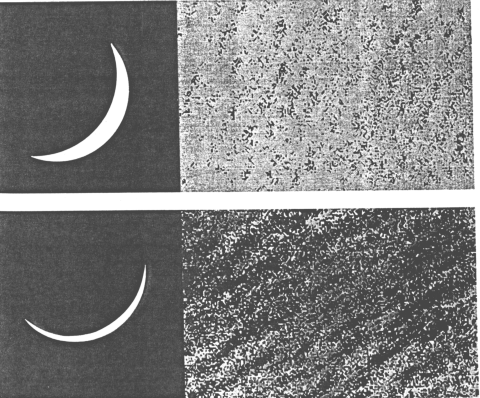
For the meticulous observer, other, more detailed, visual observations are possible. For example, you might vary your distance to the viewing surface, or use sunglasses having different colors and densities. You can also study the bands' evolution by noting their speed and the direction of motion of features within the bands (as opposed to the motion of the bands themselves). Assess the color, contrast, separation, and how the ratio of light areas to dark ones varies with time. A single band might be followed to estimate its lifetime. (You might prepare for this type of observation by watching ripples on a pond.)

As mentioned, the atmospheric turbulence responsible for shadow bands is mainly within a few thousand feet of the ground. This is the same part of the atmosphere that affects the image-wander component of "seeing" in telescopes, and, therefore, sites with poor seeing might be better at making shadow bands. So, whether or not you see shadow bands, you could look at a star with a telescope during totality to assess the quality of seeing. By evaluating the visibility of the bands at various sites along with the seeing, a trend might be established.
Photographic observations.
Despite a few successes, truly high-quality photo graphs of shadow bands remain elusive. However, advances in both film technology and camera automation in receat years should make it possible to take unprecedented photographs during the total eclipse in July.
Since the light level changes rapidly just before and after totality, thorough planning of exposure times is required. It is important to use short exposures to freeze the motion of the bands. The bands typically move 1 to 2 feet per second in light wind, so to hold blurring to 10 percent of a typical band's spacing, exposure times must be 1/125 second or less. Use shorter exposures if the wind is blowing harder.
An appropriate f/stop can be computed by scaling a film's full-daylight exposure values to the percentage of sunlight available. If all this seems like too much work, you can simply use an automatic-exposure camera! Regardless of how light or dark the background is, such a camera will make the exposure correct for extracting the maximum information from the photograph. Try to shoot a uniform background, such as a projection screen, that doesn't contain features that could be mistaken for the bands.
Reports of shadow bands have accompanied almost every eclipse in modern times. Scores of observations have appeared in the pages of Sky & Telescope during the past half century. Most observers are content with characterizing the bands' size, shape, and direction and speed across the ground. But noteworthy for its departure from our "scientific" mind-set is the prose of Rebecca R. Joslin in her 1929 book Chasing Eclipses.
Joslin ventured around the world pursuing eclipses in 1905, 1914, and 1925. For her third encounter with the Moon's shadow it was a bone-chilling - 2· Fahrenheit on the morning of January 24th. She and her friends awaited totality atop a snow-covered hill on the outskirts of Norwich, Connecticut.
Activity "was suddenly brought to a close," she writes, "by the arrival from Venus of fairies, waving their gossamer scarfs (prosaically called 'shadow- bands') and dancing so fast, oh so fast and airily, that we were bewildered in our attempt to chase them. Their scarfs flickered and shimmered and fluttered at right angles to and away from the sun, now in the air, now on the snow. But as for breadth, and texture, and number, one might as well have tried to count the flutters of the wing of a hummingbird in flight!"
There are many possible variations for photographers. For example, try taking color photographs with the new highspeed films. And since the bands' contrast improves toward the blue end of the spectrum, an interesting sequence might be made through colored filters. A picture recording the bands in near-ultraviolet light might be particularly informative. Be creative!
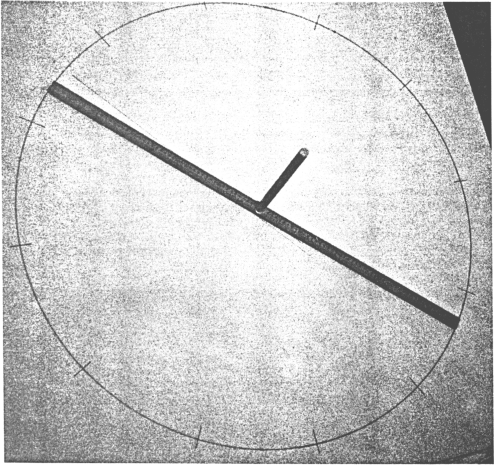
To enhance the visibility of the bands, I suggest a high-tech approach: computerized image processing. Since many amateurs now owni home computers, such manipulations are a real possibility. Once the photographs are developed, they can be converted for computer analysis by using a video digitizer or scanning the photograph with a device like those used for desktop publishing.
Various scanners and digitizers have diifferent numbers of "quantization levels". Let's assume that a scanner digitizes into 8-bit data, or 256 shades of gray. If the scan is run so that the full range is utilized, a minimum contrast differentiation of about 0.4 percent should be possible, allowing five to seven shades of gray for the shadow bands.
Image-processing programs allow you to stretch the contrast around any light level you want. (By using a color scanner it is also possible to enhance the colors of the bands.) With the image enhancements these programs perform, it may be possible to portray features never seen before. These are uncharted waters for the adventurous!
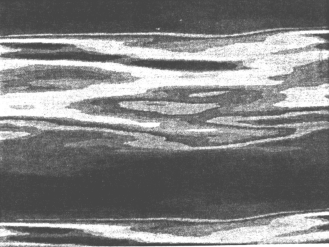
Video.
With videocameras now widely available, it's natural to think of making movies of the bands. But that may prove more difficult than it seems. Most videocameras are able to distinguish only about 30 brightness levels, while shadow bands are at most about 1/50 the full-light level. This means that most videocameras probably can't distinguish the bands at all.
An alternative would be to make an old-fashioned film movie of the bands. Exposures could be determined as for still photography; then the individual frames could be transferred to videotape or digitally processed to generate an enhanced motion picture.
Point measurements of intensity fluctuations.
A classic technique for studying fluctuating light patterns is to use photo-detectors to record brightness changes as the patterns drift by. I discuss this method in my Astronomy and Astrophysics paper. It is well understood and has been used by Marschall and his colleagues to study shadow bands (Applied Optics, Vol. 23, 4,390, 1984).
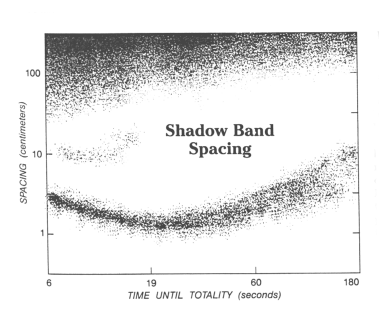
I mentioned earlier that, due to the limited response of the eye, very windy conditions might make the shadow bands disappear. Yet they can still be detected electronically; in fact, high-wind-speed observations are even desirable. Anyone attempting to apply this technique should read Marschall's paper and also mine. The interesting physics here lies in the rapidly changing spectrum of light fluctuations.
Environmental characterization.
Any shadow-band experiment that is to be thoroughly analyzed must include a detailed characterization of the observational environment. It would be best, of course, to send up a weather balloon to measure wind speed, temperature, and turbulence. But few will be able to do so. Instead, try to record the humidity, ground topography, recent weather, and so on. Basically, any information that might help determine the state and distribution of turbulence in the atmosphere would be helpful.
Data analysis and collection.
Shadow-band observations made by amateurs, accompanied by appropriate explanations and the location at which they were made, should be sent to Sky & Telescope. (Do not combine these with other eclipse reports or photographs; use a separate envelope.) The data should be analyzed as much as possible before submission.
Good luck in planning your experiments and carrying them out. By working together, we can look forward to a much better understanding of shadow bands, a unique effect of atmospheric optics. What's more, amateurs will have done the job!